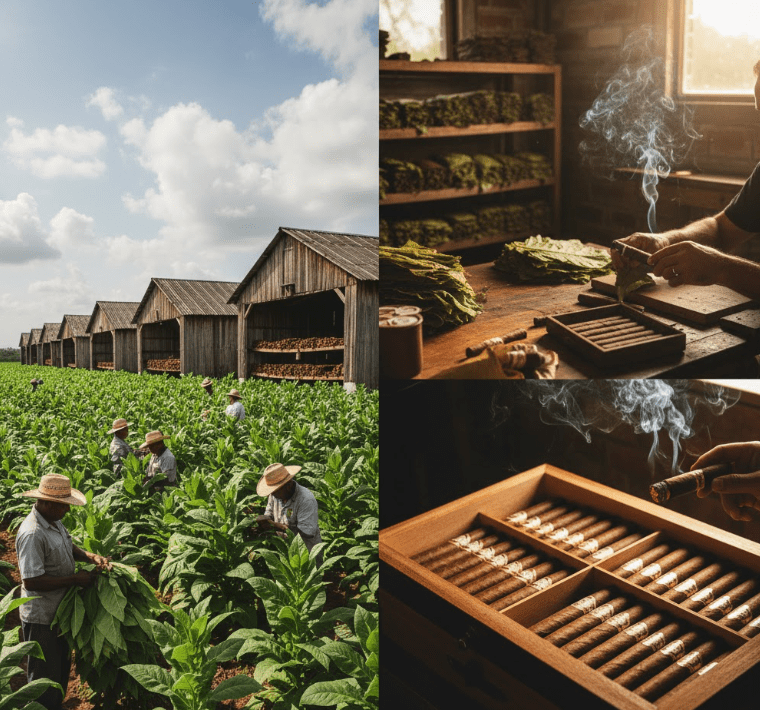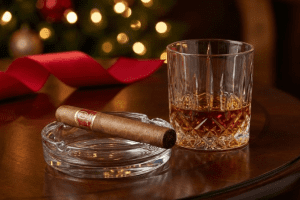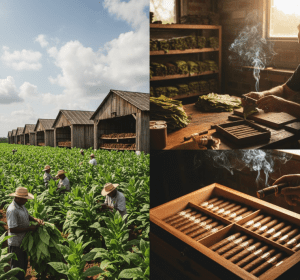Every great cigar begins not with smoke — but with soil.
Long before a León Jimenes cigar ever reaches a humidor, its story unfolds through seasons of care, craftsmanship, and patience. From the seed’s first sprout in the Dominican sun to the final draw that releases its aroma, each stage of this journey reflects the dedication that defines premium cigar making.
This is the story of how passion becomes tradition — and how every puff carries the soul of the Dominican Republic.
1. The Seed: Where Heritage Takes Root
Each León Jimenes cigar begins with seeds selected for their lineage — small, yet powerful, containing the potential for flavor and balance.
In the fertile soils of the Cibao Valley, these seeds are nurtured in carefully controlled nurseries before being transplanted into open fields. Farmers tend them by hand, protecting the delicate leaves from harsh winds and excess sunlight.
Here, the Dominican terroir does its magic: mineral-rich soil and the island’s tropical rhythm create a tobacco unlike any other — smooth, aromatic, and full of character.
2. The Harvest: A Season of Precision
When the leaves reach maturity, the harvest begins — not all at once, but leaf by leaf, stalk by stalk.
Lower leaves offer mild flavor and smooth combustion; upper leaves, known as ligeros, bring strength and depth. Each is destined for a specific role — wrapper, binder, or filler — in the cigar’s construction.
The harvest is a delicate dance of timing, experience, and respect for nature.
3. Fermentation & Aging: Where Character Is Born
After harvesting, the leaves are stacked in large pilones (fermentation piles), where heat and humidity transform raw tobacco into aromatic, flavorful leaves.
This natural fermentation process removes bitterness and develops the subtle notes — wood, spice, cocoa, honey — that define a cigar’s complexity.
Once fermented, the leaves are aged in cedar-lined rooms for years, breathing in the wood’s essence and gaining smoothness. Some León Jimenes tobaccos rest for up to a decade, ensuring the signature refinement the brand is known for.
4. Rolling: The Hands of the Masters
Few crafts rival the artistry of cigar rolling.
At La Aurora’s factory in Santiago, master torcedores (rollers) combine precision with intuition, selecting the perfect blend of filler, binder, and wrapper to achieve harmony in flavor and draw.
Each cigar passes through the hands of artisans who have spent years perfecting the balance of pressure and proportion.
The result: consistency, structure, and beauty — the unmistakable hallmark of León Jimenes craftsmanship.
5. Quality Control & Aging Once More
Before release, every cigar is inspected for texture, color, aroma, and construction.
Then, like fine wine, cigars are aged again in climate-controlled rooms, allowing their flavors to marry and mature into the distinctive smoothness that aficionados recognize instantly.
It’s patience rewarded — perfection sealed in cedar and time.
6. The Final Journey: Smoke and Legacy
When you light a León Jimenes cigar, you’re not just enjoying tobacco; you’re experiencing a century-long dialogue between soil, craft, and passion.
From the first ember to the final exhale, every note carries the story of generations who transformed simple leaves into an art form.
Because true luxury isn’t made — it’s cultivated.
FAQ
1. What is the life cycle of a premium Dominican cigar?
The life cycle of a premium Dominican cigar begins with seed selection, continues through field cultivation, hand-harvesting, fermentation, long-term aging, expert rolling, and final quality control before aging again in cedar rooms. Each step ensures the cigar’s flavor, aroma, and combustion quality.
2. What makes Dominican tobacco unique?
Dominican tobacco is prized for its smoothness, balance, and aromatic complexity. Grown in the fertile soil of the Cibao Valley, the leaves develop naturally rich flavors thanks to ideal humidity, mineral-rich earth, and generations of craftsmanship.
3. How long does it take to make a premium cigar like León Jimenes?
Producing a premium cigar can take between 2 and 10 years, depending on how long the tobacco is aged. Leaves undergo fermentation, multiple aging stages, and careful quality inspection before the cigar is ready for sale.
4. What is the difference between wrapper, binder, and filler?
- Wrapper: The outermost and most delicate leaf, responsible for much of the aroma and appearance.
- Binder: Holds the filler together and affects burn consistency.
- Filler: Blended inner leaves that define body, strength, and flavor.
Together, they determine the cigar’s overall profile.
5. Why is fermentation important in cigar production?
Fermentation removes ammonia and bitterness while enhancing natural aromas. This controlled process develops notes like wood, cocoa, spice, or honey — essential for a smooth, refined Dominican cigar.
6. How are premium cigars rolled?
Premium cigars are hand-rolled by master torcedores who combine filler, binder, and wrapper with precise pressure and technique. The goal is perfect airflow, even burning, and consistent flavor in every cigar.
7. Why are cigars aged after rolling?
Post-rolling aging allows the oils in the tobacco to harmonize. This final step smooths the draw, enriches flavor, and ensures that premium cigars maintain their aromatic complexity once smoked.
8. What factors influence the flavor of a premium cigar?
Flavor is shaped by:
- Soil and climate (terroir)
- Leaf position on the plant
- Fermentation length
- Aging process
- Rolling technique
- Storage in cedar humidors
Each factor contributes to the cigar’s strength, aroma, and smoothness.
9. Are Dominican cigars considered the best in the world?
Dominican cigars — including brands like León Jimenes — are globally recognized for their craftsmanship, consistency, and smooth profiles. The Dominican Republic is considered one of the world’s top premium cigar producers, alongside Cuba and Nicaragua.
10. How should premium cigars be stored at home?
Premium cigars should be stored in a cedar-lined humidor at 65–70% humidity and around 70°F (21°C). This protects the oils in the tobacco and preserves the cigar’s flavor, aroma, and burn quality.


